Some of the most distinctive blue birds with orange chests include the eastern and western bluebirds, lazuli bunting, blue-throated macaw, as well as many species of kingfishers and blue flycatchers. But this striking color combination appears across a wide range of bird families around the world.
This article looks at the different species that share this combination of blue plumage with orange chests or bellies, helping you identify the bird you saw by considering its appearance, vocalizations, habitat, and geographic range.
Eastern bluebird (Sialia sialis)
- How it looks: Small thrush with bright blue upperparts and a rich orange chest and flanks; white belly.
- Where found: Open habitats in eastern and central North America, including fields, orchards, and forest edges.
- Conservation status: Least Concern; populations stable or increasing due to conservation measures.

The eastern bluebird is a small thrush, approximately 20 cm (7.9 in) in length, easily recognized by the adult male’s vivid blue upperparts and deep orange throat and chest, which extends along the flanks and contrasts sharply with a clean white belly. This blue-and-orange coloration is distinctive among North American passerines. Females are duller, with a grayish-blue back and paler orange on the underparts. Their vocalizations include a soft, musical warble and a low-pitched, mellow “cheer” or “chur-lee” call, frequently heard during the breeding season.
Listen to the eastern bluebird song:
This species occupies open and semi-open habitats across eastern and central North America, from southern Canada to parts of Mexico. It prefers areas with scattered trees, such as pastures, orchards, forest edges, and suburban parks. Their diet is primarily insectivorous in summer, shifting to berries in colder months. Eastern bluebirds are cavity nesters and have benefited from widespread nest box programs, which helped reverse declines caused by habitat loss and competition with invasive species.
Western bluebird (Sialia mexicana)
- How it looks: Small thrush with deep blue upperparts and a rusty orange chest and flanks; grayish belly.
- Where found: Open woodlands, montane meadows, and forest edges in western North America.
- Conservation status: Least Concern; populations stable or increasing in many areas.

The western bluebird is a small thrush, about 18 cm (7.1 in) in length, with dark blue upperparts and a rich orange chest that extends along the flanks. The belly is grayish, giving the species a more muted appearance than the eastern bluebird. Females are similar in pattern but noticeably duller, with grayish-blue backs and paler orange underparts. Its vocalizations include a soft, repeated “cheer” or “few” call and short, melodic warbles heard especially during the breeding season.
Listen to the western bluebird call and song:
Western bluebirds are found in open forests and woodland edges across the western United States, from British Columbia to central Mexico. They breed in montane meadows, coniferous forests, oak savannas, and areas with scattered trees, and often move to lower elevations in winter. As cavity nesters, they readily occupy nest boxes and are frequently seen in areas where such conservation efforts are in place. Their diet shifts seasonally from insects to berries and small fruits, including elderberry, juniper, and mistletoe.
Lazuli bunting (Passerina amoena)
- How it looks: Small songbird with bright blue head and back, rusty-orange chest, white belly, and white wingbars.
- Where found: Breeds across western North America from southern Canada to northern Mexico; winters in southeastern Arizona and Mexico.
- Conservation status: Least Concern; population large and increasing across much of its range.

The lazuli bunting is a vividly colored North American passerine, about 15 cm (5.9 in) in length. Adult males are unmistakable, with a brilliant blue head, nape, and back, a rusty-orange chest limited to the upper breast, and a sharply contrasting white belly. Two bright white wingbars stand out against darker wings. Females are more subdued, with warm brown upperparts and pale underparts. The species’ song is a sweet, musical warble, and its call a sharp “pik” or “tick” given frequently from shrubs or wires.
Listen to the lazuli bunting song:
This species breeds across a broad swath of western North America, from southern Canada to Texas, New Mexico, Arizona, and coastal California, with some populations reaching northern Baja California. During migration and winter, it moves to the southwestern U.S. and Mexico. Preferred habitats include brushy areas, streamside thickets, weedy fields, and even suburban gardens – generally in well-watered areas. The lazuli bunting is common in many parts of its range and adapts well to semi-open and disturbed habitats.
Barn swallow (Hirundo rustica)
- How it looks: Slender swallow with glossy blue upperparts, long forked tail, and rusty-orange chest and belly (in the American subspecies).
- Where found: Breeds across the Northern Hemisphere; H. r. erythrogaster found in North America, migrating to Central and South America.
- Conservation status: Least Concern; extremely large and widespread population, though locally declining in some areas.
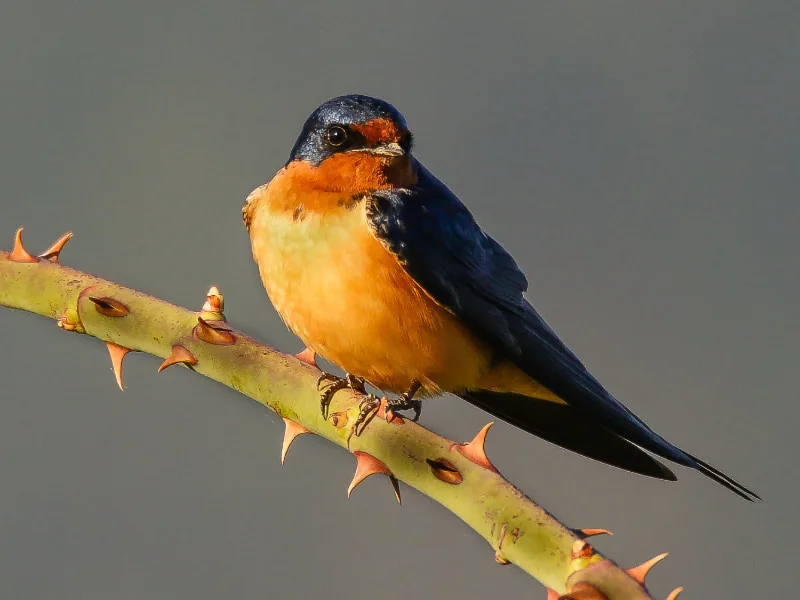
The barn swallow is a graceful, fast-flying passerine, averaging about 18 cm (7.1 in) in length, including its long, deeply forked tail. Adult birds have glossy blue upperparts and crown, with a chestnut-red throat and forehead. In the North American subspecies (H. r. erythrogaster), the chest and belly are a rich rusty-orange, giving it a strong blue-and-orange appearance ideal for inclusion in this article. Other subspecies, such as the Eurasian H. r. rustica, have paler or buff-colored underparts and a more distinct dark chest band. Males typically have longer tail streamers than females. The species gives a sharp “twit” call and a cheerful, twittering song often heard near nests.
Listen to the barn swallow song:
The barn swallow is one of the most widespread bird species in the world, breeding throughout North America, Europe, Asia, and parts of North Africa. The H. r. erythrogaster subspecies breeds from southern Canada to Mexico and migrates to Central and South America for the winter. Barn swallows nest in open country, farms, and urban areas, attaching their mud nests to buildings, bridges, or cliffs. While local declines have been reported due to habitat change and loss of nesting sites, the global population remains extremely large and stable.
Rufous-chested swallow (Cecropis semirufa)
- How it looks: Large swallow with dark blue upperparts, brick-red rump, and rich orange-rufous throat, chest, and belly.
- Where found: Dry open country across Sub-Saharan Africa; retreats to tropical forest zones during the wet season.
- Conservation status: Least Concern; widespread and increasing across its broad African range.
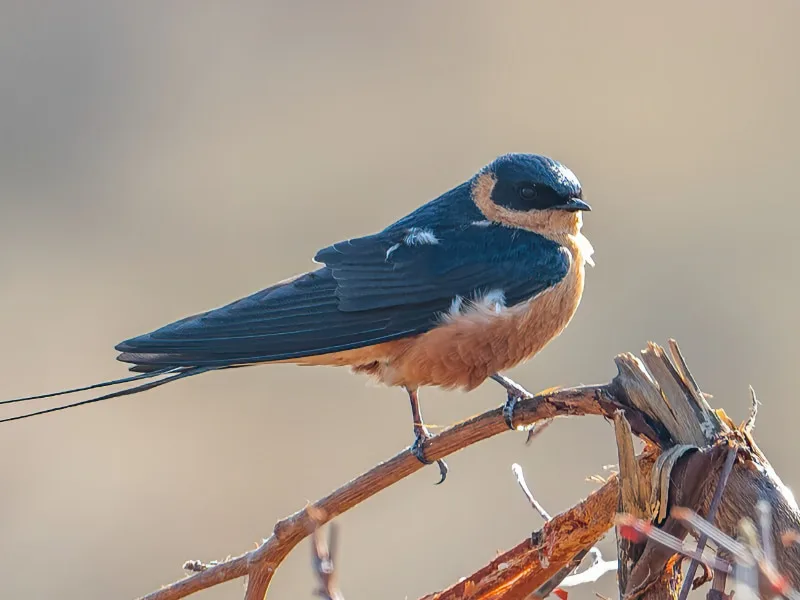
The rufous-chested swallow is a large, striking swallow, measuring about 24 cm (9.4 in) in length including its long, tapered tail. Adult birds have glossy dark blue upperparts, a brick-red rump, and a deep orange to rufous wash across the throat, chest, and belly, giving them a vivid blue-and-orange appearance in flight and at rest. The underparts are often unmarked, though some variation may occur. The species has a mellow twittering call and is often silent when alone.
Listen to the rufous-chested swallow song:
This swallow is widely distributed across Sub-Saharan Africa and is typically associated with dry, open country, grasslands, savannah, and agricultural zones. It avoids forest interior but may enter tropical forest zones seasonally during the wet season. Unlike many other swallows, the rufous-chested swallow is generally solitary or found in pairs, with little tendency to form breeding colonies. It nests in natural cavities or structures, often constructing a mud-lined cup nest. Its population is believed to be stable or even increasing, and it remains common in many parts of its range.
Blue-and-yellow tanager (Rauenia bonariensis)
- How it looks: Medium-sized tanager with deep blue head and upperparts, some black on the back, and rich orange-yellow chest and belly.
- Where found: Widespread in South America, from Argentina and Uruguay north to Peru and Ecuador; found in a variety of forested and shrubby habitats.
- Conservation status: Least Concern; stable and widespread across much of southern and central South America.

The blue-and-yellow tanager is a vividly colored South American songbird, about 17 cm (6.7 in) in length. Adult males have a striking deep blue head, nape, and upperparts, with black markings across the back and wings. Despite its name, the underparts are often closer to orange than yellow, especially on the chest and belly, creating a strong contrast with the blue upperparts. Its call is a short, sharp “tsip,” and its song is a sweet, warbled phrase often given from elevated perches.
Listen to the blue-and-yellow tanager call and song:
This species is found across a wide range of habitats in Argentina, Uruguay, Brazil, Paraguay, Bolivia, and the Andes of Peru and Ecuador. It occurs in subtropical and tropical dry forests, moist lowland and montane forests, high-altitude shrublands, and even heavily degraded former forest. While generally resident, populations in southern parts of its range may migrate northeastward during the austral winter into Paraguay and eastern Bolivia. It is adaptable, relatively common, and not currently facing significant threats.
Blue-backed conebill (Conirostrum sitticolor)
- How it looks: Small tanager with rich blue upperparts, black head and throat, and deep orange underparts; short, conical bill.
- Where found: Montane forests of the Andes in Colombia, Venezuela, Ecuador, Peru, and Bolivia.
- Conservation status: Least Concern; widespread throughout the Andes with only minor population declines.
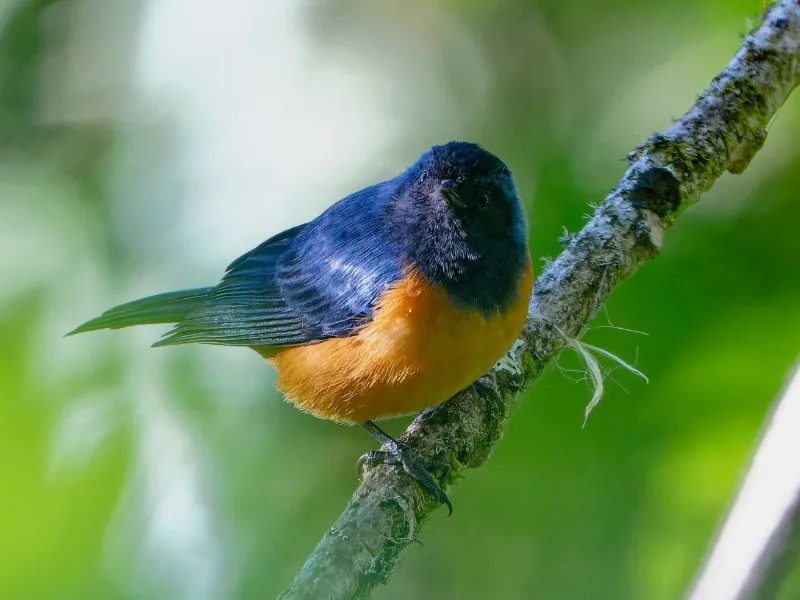
The blue-backed conebill is a compact Andean songbird, measuring around 13 cm (5.1 in) in length. Adults are strikingly colored, with deep cobalt-blue on the back, wings, and rump, a black hood extending from the head to the upper chest, and rich orange underparts. The blue tones are especially vibrant in good light, contrasting with the jet-black face. The species gives short, thin call notes and fast warbling songs, usually from within the forest canopy or edges.
Listen to the blue-backed conebill song:
This species is found in humid montane forests from Venezuela to Bolivia, usually at elevations between 1,800 and 3,500 meters. It frequents forest edges, mossy thickets, and upper canopy layers, often moving with mixed-species flocks. Though habitat loss from deforestation poses some threat, the species remains fairly adaptable and continues to be common across much of its elevational range. It is currently assessed as Least Concern.
Rufous-bellied niltava (Niltava sundara)
- How it looks: Medium-sized flycatcher with deep blue to blackish-blue upperparts and a rich orange chest and belly.
- Where found: Subtropical and montane forests across the Himalayas and Southeast Asia, from Pakistan and Nepal to Vietnam.
- Conservation status: Least Concern; widespread with a stable population, though possibly declining in some areas.
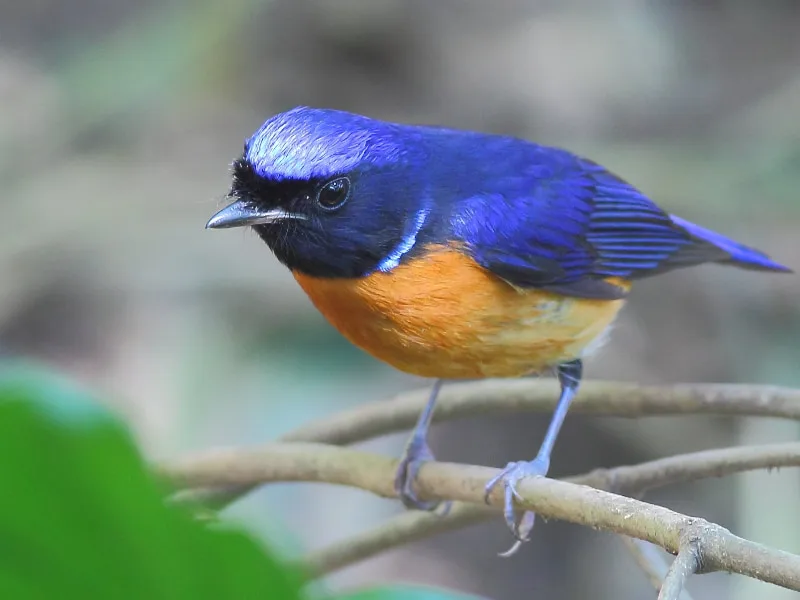
The rufous-bellied niltava is a striking forest flycatcher, typically around 17 cm (6.7 in) in length. Adult males have glossy dark blue to nearly black upperparts, with rich orange on the chest, belly, and flanks. The contrast between the dark head and back and the bright underparts is especially bold in shaded forest light. Females are much duller, with olive-brown upperparts and dull grayish underparts. The call is a soft, rising whistle, and the song is a short, sweet warble often delivered from low perches.
Listen to the rufous-bellied niltava call:
This species inhabits subtropical and tropical moist forests across a wide range stretching from Pakistan and the Himalayas to southern China and mainland Southeast Asia. It is typically found in understorey or lower midstorey layers of dense forest, often near streams or ravines. While some populations may be experiencing local declines due to habitat loss, the species remains widespread and is currently assessed as Least Concern.
Indian blue robin (Larvivora brunnea)
- How it looks: Small ground-dwelling robin with dark blue upperparts, orange chest and flanks, and white belly; a white supercilium is prominent.
- Where found: Breeds in Himalayan forests; winters in the Western Ghats and Sri Lanka; favors dense understorey in moist hill forests.
- Conservation status: Least Concern; widespread and migratory, with no evidence of rapid population decline.

The Indian blue robin is a small forest thrush, around 15 cm (5.9 in) in length, notable for its strong coloration and secretive behavior. Adult males have deep blue upperparts, a bright orange chest and flanks, and a sharply contrasting white belly. A bold white supercilium (eyebrow stripe) extends from the bill to behind the eye. Females are much duller, with olive-brown upperparts, a paler orange wash on the chest, and a less distinct facial pattern. The song is a short, warbling series of phrases, while its call is a sharp, high “tseep,” often heard from dense cover.
Listen to the Indian blue robin call and song:
This species breeds in the temperate and moist forests along the Himalayas, including Nepal, northern and eastern India, Bangladesh, and parts of Myanmar. It migrates to the hill forests of the Western Ghats and Sri Lanka during the non-breeding season, where it favors dense understorey and leaf litter in moist evergreen or semi-evergreen forest. Though often difficult to spot, it is locally common in suitable habitat.
Rufous-breasted bush robin (Tarsiger hyperythrus)
- How it looks: Small robin with deep blue upperparts, bright orange chest, and pale belly; a pale supercilium is present.
- Where found: Temperate forests of the eastern Himalayas and southwestern China; inhabits dense undergrowth and forest edges.
- Conservation status: Least Concern; stable population across a broad range in montane forest regions.
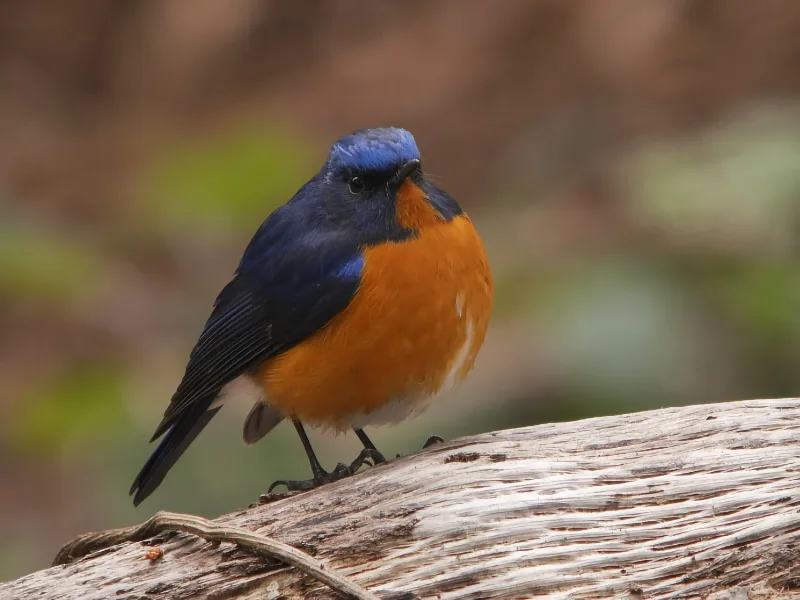
The rufous-breasted bush robin is a small, secretive forest species, around 13 cm (5.1 in) in length. Adult males have dark blue upperparts, including the head, back, and tail, a striking orange chest, and a contrasting pale belly. A narrow pale supercilium runs above the eye, and the wings often show darker blue-black tones. Females are duller, with brownish upperparts and a warm buff-orange wash on the chest. The song is a soft, high-pitched series of whistles, and the call is a dry “tsik,” typically heard from dense understorey vegetation.
Listen to the rufous-breasted bush robin song:
This species inhabits temperate broadleaf and mixed forests from the eastern Himalayas east into southwestern China. It occurs in Bhutan, Nepal, northeast India, northern Myanmar, Bangladesh, and Yunnan province in China. It prefers cool, shaded areas with dense undergrowth, forest edges, and thickets, often at mid to high elevations during the breeding season. Despite being somewhat inconspicuous, it is considered locally common in suitable habitat.
Orange-bellied flowerpecker (Dicaeum trigonostigma)
- How it looks: Tiny bird with grey-blue head and back, a small orange mantle, and bright orange chest and belly.
- Where found: South and Southeast Asia, from Bangladesh and Myanmar to the Philippines and Indonesia; found in lowland and montane forests.
- Conservation status: Least Concern; very widespread, with only minor population decline in parts of its range.
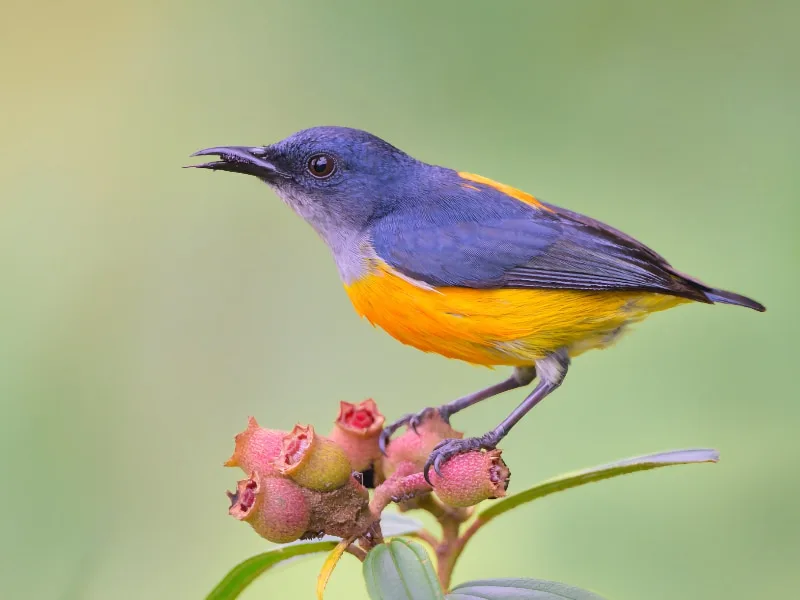
The orange-bellied flowerpecker is a compact and colorful canopy species, measuring around 9 cm in length. Males have a steel-blue head and back, a bright orange patch on the mantle, and vivid orange underparts that may fade to paler tones toward the belly. The wings are dark with a blue gloss. Females are much duller, with yellowish underparts and brownish-olive above, lacking the orange and blue tones entirely. Their call is a sharp, high-pitched “tsit-tsit,” often heard as they dart quickly among flowering trees.
Listen to the orange-bellied flowerpecker call:
This species is found in a variety of forested habitats across South and Southeast Asia, including Bangladesh, Myanmar, Thailand, Malaysia, Brunei, Indonesia, the Philippines, and Singapore. It occupies subtropical and tropical moist lowland and montane forest, as well as mangroves and secondary growth. It feeds mainly on nectar and small fruits, playing a role in pollination and seed dispersal. Though habitat loss affects some parts of its range, the species remains widespread and adaptable.
Blue-throated macaw (Ara glaucogularis)
- How it looks: Large macaw with vibrant turquoise-blue upperparts, golden-yellow to orange chest and belly, and a blue patch on the throat.
- Where found: Endemic to the Llanos de Mojos savannas in northern Bolivia; found in forest islands and gallery forests.
- Conservation status: Critically Endangered; among the world’s rarest parrots, with a fragmented and still fragile wild population.
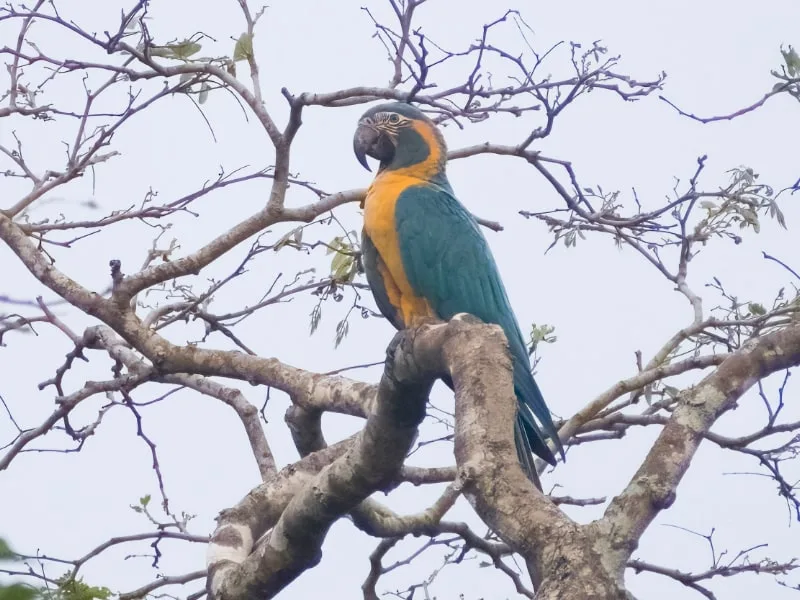
The blue-throated macaw is a strikingly colored, large parrot reaching up to 85 cm in length, including its long, tapering tail. Adults have vivid blue plumage on the head, wings, back, and tail, while the underparts range from bright yellow to deep orange. A distinct blue patch on the throat gives the species its name. The bare facial skin is lined with rows of black feather lines, typical of Ara macaws. Both sexes look alike. The species is most frequently seen in pairs, though small flocks and a single large non-breeding roost are also recorded. Vocalizations are loud, sharp screeches and croaks, used to maintain contact in flight or near nests.
Listen to the blue-throated macaw call:
Endemic to northern Bolivia, the blue-throated macaw is one of the world’s rarest and most threatened parrots. It inhabits Motacu palm forest islands and gallery forest in the Beni Savannas, nesting in large tree cavities. The species declined severely due to trapping and habitat loss, and today fewer than 500 individuals remain, split across three isolated subpopulations. Although conservation efforts, including nest boxes, reintroduction, and habitat restoration, have stabilized numbers, most birds breed on private ranches where habitat degradation continues to threaten recovery.
Common kingfisher (Alcedo atthis)
- How it looks: Small, compact kingfisher with bright blue upperparts, orange chest and belly, and white throat; long black bill.
- Where found: Widespread across Europe, Asia, and North Africa; found along rivers, streams, lakes, and wetlands.
- Conservation status: Least Concern; widespread and numerous, with only slow population decline in parts of its range.
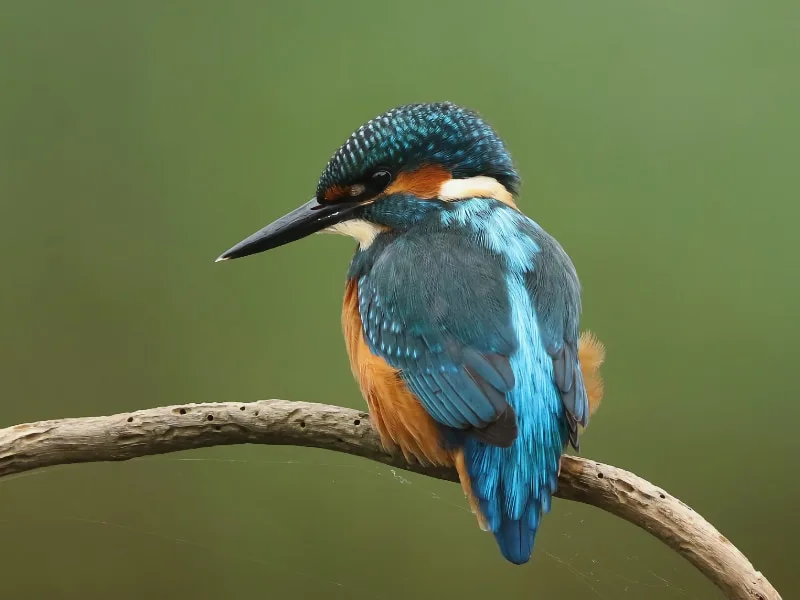
The common kingfisher is a small, vividly colored bird, about 16 cm in length, instantly recognizable by its brilliant blue back, wings, and crown, contrasted by a deep orange chest and belly. A white throat and neck patch provide further contrast, and the long, straight black bill is adapted for catching fish. Males and females are similar, but females typically have some orange at the base of the lower mandible. Its high-pitched call is often heard as it darts low over the water.
Listen to the common kingfisher call:
This species occupies a wide range of freshwater habitats throughout Europe, Asia, and North Africa, favoring clean rivers, streams, lakes, and wetlands with overhanging vegetation. It perches low near water and hunts by plunge-diving for small fish and aquatic invertebrates. Although sensitive to water pollution and habitat degradation, the common kingfisher remains widespread and locally abundant. While some regional declines have been noted, particularly in disturbed or polluted habitats, the overall population is large and stable.
Shining-blue kingfisher (Alcedo quadribrachys)
- How it looks: Small kingfisher with dark, glossy blue upperparts, deep orange underparts, and a short white throat patch.
- Where found: Streams and shaded wetlands in equatorial Africa; prefers dense forest near freshwater.
- Conservation status: Least Concern; widespread with a stable population across its range.
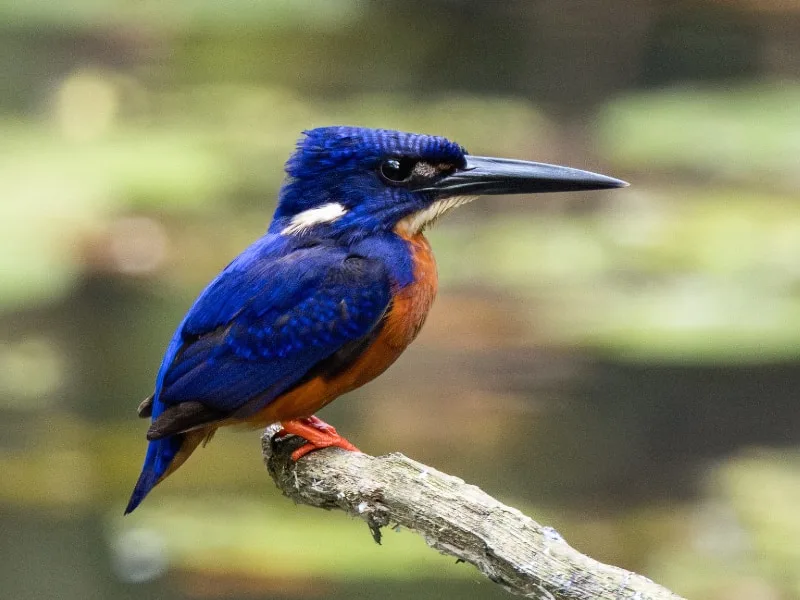
The shining-blue kingfisher is a small, forest-dwelling kingfisher about 16 cm (6.3 in) in length. Adult birds have deep, glossy blue plumage on the head, back, and wings, with dark bluish cheeks and a short white patch at the throat. The underparts are rich orange, extending from the chest through the belly. The bill is strong, straight, and black. Both sexes appear similar, and the species is usually silent, though a sharp “tsip” call may be heard in flight.
Listen to the shining-blue kingfisher call:
This kingfisher is found in equatorial Africa, from West Africa through the Congo Basin and into parts of Central and East Africa. It inhabits shaded streams, forested wetlands, and dense riparian vegetation, often remaining close to cover. It feeds mainly on fish and aquatic insects, diving from low perches near the water’s surface. Although it is somewhat secretive and can be overlooked, it remains locally common throughout its broad range.
Blue-eared kingfisher (Alcedo meninting)
- How it looks: Small kingfisher with deep blue upperparts, dark rufous-orange underparts, and a dark crown.
- Where found: Forest streams and shaded waterways across the Indian subcontinent and Southeast Asia.
- Conservation status: Least Concern; widespread, with possible slow declines due to habitat degradation.

The blue-eared kingfisher is a small, fast-moving kingfisher about 16 cm (6.3 in) in length. Adult males have glossy deep blue upperparts, including the crown, wings, and tail, and rich, dark rufous-orange underparts. The species is named for its blue ear coverts, which replace the rufous ear stripe found in the similar common kingfisher. The crown and back are darker blue, and the white throat patch is small and discrete. Males have an entirely black bill, while females show a reddish-orange lower mandible. The call is a high, thin “tsee” often given in rapid flight over water.
Listen to the blue-eared kingfisher call:
This species is found across much of tropical Asia, including India, Nepal, Bangladesh, Sri Lanka, Myanmar, Thailand, Malaysia, Indonesia, and the Philippines. It inhabits dense, shaded forests and riparian habitats, typically along small streams and forested creeks, where it hunts for small fish and aquatic invertebrates. While it is more secretive than the common kingfisher and less frequently observed, it remains widespread in suitable habitat. Although habitat degradation may be contributing to local declines, overall population trends are not rapid.
Half-collared kingfisher (Alcedo semitorquata)
- How it looks: Medium-sized kingfisher with deep blue upperparts, white throat, and orange underparts.
- Where found: Streams, rivers, and lakes in southern and eastern Africa, usually with dense shoreline vegetation.
- Conservation status: Least Concern; widespread, with no evidence of rapid population decline.
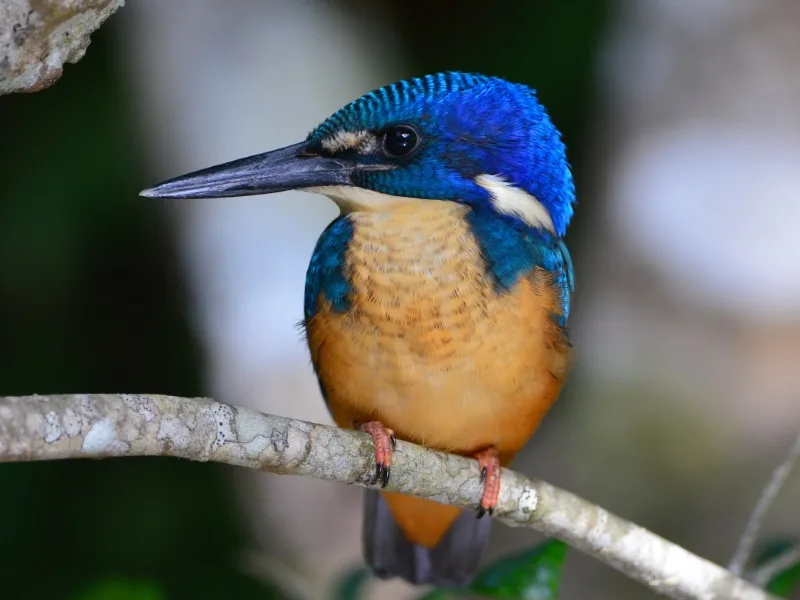
The half-collared kingfisher is a medium-sized, stream-adapted kingfisher, measuring about 18 cm (7.1 in) in length. Adults have dark blue upperparts, a white throat, and pale orange underparts. The crown is patterned with alternating light and dark blue bands, and creamy-white neck stripes flank dark blue patches that form a distinct “half collar” on either side of the neck. Males have an entirely black bill, while females show red at the base of the lower mandible. The call is a shrill, high-pitched whistle, usually given in flight.
Listen to the half-collared kingfisher call:
This species is found in southern and eastern Africa, inhabiting clean, slow-moving streams, rivers, and larger bodies of water lined with dense vegetation. It feeds almost exclusively on fish, which it catches by diving from low perches. Although somewhat shy and localized, it remains relatively widespread in suitable freshwater habitats. While habitat degradation and water pollution may pose localized threats, the overall population is believed to be stable, and the species is currently assessed as Least Concern.
Azure kingfisher (Ceyx azureus)
- How it looks: Small, slender kingfisher with deep azure-blue upperparts, rich orange chest and belly, and white throat spot.
- Where found: Streams, rivers, and wetlands in Australia, New Guinea, and nearby islands; prefers shaded, slow-moving freshwater.
- Conservation status: Least Concern; widespread with a stable population across much of its range.

The azure kingfisher is a small and vividly colored riverine kingfisher, about 18 cm (7.1 in) in length. Adult birds have glossy deep blue upperparts, a rich orange chest and belly, and a prominent white spot on the throat. The bill is long, straight, and dark, and the legs are bright red. Males and females are similar in appearance, though females may be slightly larger on average. Its call is a high-pitched, thin whistle, often heard as the bird zips low over the water.
Listen to the azure kingfisher call:
This species is found along shaded creeks, streams, and wetlands across much of Australia, New Guinea, and parts of nearby islands. It prefers densely vegetated riverbanks and forested wetlands, where it perches close to the water to hunt for small fish, insects, and aquatic invertebrates. While populations are sensitive to habitat degradation and water pollution, the species remains widespread and locally common. Declines have been noted in some areas, but overall numbers are stable, and it is currently assessed as Least Concern.
Moluccan dwarf kingfisher (Ceyx lepidus)
- How it looks: Tiny kingfisher with bright blue upperparts, deep orange underparts, and reddish bill and legs; white throat patch.
- Where found: Lowland forests and forest streams on islands of the central and northern Moluccas, Indonesia.
- Conservation status: Least Concern; widespread within its island range, though habitat loss may be causing slow decline.

The Moluccan dwarf kingfisher is a tiny, forest-dwelling species, measuring about 14 cm (5.5 in) in length. Adults have glossy blue upperparts, including the head, wings, and back, with rich orange underparts and a small white throat patch. The bill and legs are bright orange. The species shows some variation across its range: individuals from northern populations appear to have deeper, more saturated orange on the chest compared to birds from Seram and nearby islands. Its call is a sharp, high-pitched whistle, often given from within dense forest understorey.
Listen to the Moluccan dwarf kingfisher call:
This species is endemic to the Moluccan Islands of eastern Indonesia, where it inhabits lowland forest, forest edges, and shaded streams, including secondary growth. It is typically found in the understorey, where it perches quietly and hunts for insects and small prey near water. Although habitat loss from logging and agricultural conversion is an ongoing concern, the species remains fairly widespread within its fragmented island range.
Papuan dwarf kingfisher (Ceyx solitarius)
- How it looks: Tiny kingfisher with bright blue upperparts, deep orange underparts; white throat patch is small and distinct.
- Where found: Lowland forests of New Guinea, western Papuan islands, Aru Islands, and the D’Entrecasteaux Archipelago.
- Conservation status: Least Concern; widespread in forested habitats, though local declines may occur with habitat loss.
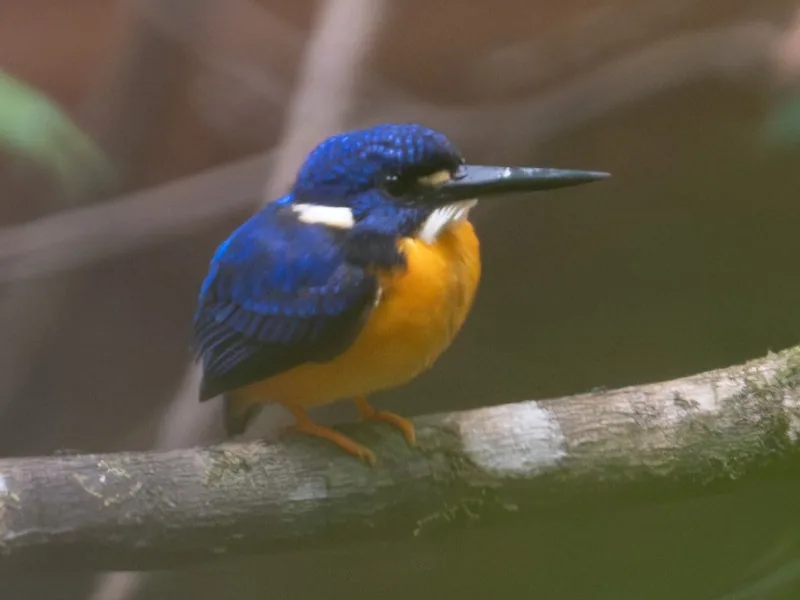
The Papuan dwarf kingfisher is one of the smallest members of its genus, measuring just 12 cm (4.7 in) in length. Adult birds have glossy blue upperparts and rich orange underparts, with a small white throat patch. The bill is dark, and the legs are red. Males and females are similar in appearance. Its call is a high, sharp whistle, often heard in dense forest but the bird itself is typically difficult to observe.
Listen to the Papuan dwarf kingfisher call:
This species is endemic to the Australo-Papuan region, occurring throughout lowland forests of New Guinea, the Aru Islands, the western Papuan islands, and the D’Entrecasteaux Archipelago. It inhabits humid tropical and subtropical forest, generally in the lower strata, and may also be found in secondary growth and forest edge. It feeds mainly on insects and other small invertebrates, foraging near the ground or from low perches. Despite its secretive habits and some ongoing habitat degradation, the species is widespread and remains common in many areas.
Dimorphic dwarf kingfisher (Ceyx margarethae)
- How it looks: Tiny kingfisher with deep blue upperparts, rich orange underparts, and red bill and legs; sexes are similar in plumage.
- Where found: Forests on central and southern Philippine islands, from sea level up to 1,000 m elevation.
- Conservation status: Least Concern; locally declining, but remains widespread across its fragmented island range.

The dimorphic dwarf kingfisher is a very small forest kingfisher, measuring about 14 cm (5.5 in) in length. Adults have glossy blue upperparts and deep orange underparts, with a white throat patch and bright red bill and legs. Despite its name, plumage dimorphism is not strongly marked; both sexes are similar in coloration. Unlike many other Ceyx species, it is often found well away from water, foraging low in the forest understorey. Its vocalizations include short, high-pitched calls, sometimes given from dense vegetation.
Listen to the dimorphic dwarf kingfisher call:
This species is endemic to the Philippines, occurring on multiple central and southern islands including Mindanao, Negros, Cebu, Siquijor, Romblon, Sibuyan, and the Sulu Archipelago. It occupies a range of wooded habitats, including primary and secondary rainforest, monsoon forest, dense second growth, and overgrown plantations, generally up to 1,000 m. It is typically terrestrial or near-ground dwelling, feeding on insects and small invertebrates. Although forest clearance and habitat degradation are ongoing threats, it remains widespread in fragmented habitats.
Buff-breasted paradise kingfisher (Tanysiptera sylvia)
- How it looks: Large kingfisher with deep blue upperparts, bright orange throat and chest, pale belly, white back stripe, and long white tail streamers.
- Where found: Forests of New Guinea and northeastern Australia; breeds in rainforest of North Queensland.
- Conservation status: Least Concern; population may be slowly declining but remains widespread and locally common.

The buff-breasted paradise kingfisher is a striking and unusually long-tailed forest kingfisher, measuring up to 35 cm (13.8 in) in total length, including its elongated white tail streamers. Adult birds have deep blue upperparts and wings, a broad white horizontal stripe across the back, and a rich orange throat and chest that fade into a pale buff or whitish belly. The long, red-orange bill and bright red legs further add to its distinctive appearance. Its call is a sharp, metallic “chik” or “kleeek,” often given during territorial displays.
Listen to the buff-breasted paradise kingfisher call:
This species breeds in the tropical rainforests of North Queensland, Australia, after migrating from non-breeding grounds in New Guinea each year around November. During the breeding season, it nests in termite mounds on the forest floor, a behavior shared with some other paradise-kingfishers. Outside the breeding season, it occupies lowland forest and forest edge habitats across southern New Guinea. Although the population may be slowly declining due to habitat loss, particularly in its Australian breeding range, it remains widespread and is currently assessed as Least Concern.
Blue-fronted redstart (Phoenicurus frontalis)
- How it looks: Small songbird with deep blue head, throat, and upperparts; bright orange chest and belly.
- Where found: Himalayan and central Asian mountain forests and shrubby slopes; breeds at high elevations.
- Conservation status: Least Concern; widespread and locally common within its breeding range.

The blue-fronted redstart is a small passerine, around 16 cm (6.3 in) in length, found across the Himalayan region and parts of central Asia. The adult male is strikingly colored, with dark blue plumage covering the head, throat, back, and wings, contrasted by a vivid orange chest, belly, and vent area. The tail is also orange with a dark center. Females are much plainer, with brownish upperparts and warm buff-orange underparts. Its vocalizations include a short, warbling song and high, sharp “tseet” calls, particularly during the breeding season.
Listen to the blue-fronted redstart call:
This species breeds in alpine and subalpine habitats, including coniferous and mixed forests, rhododendron thickets, and shrubby hillsides, usually between 3,000 and 4,500 m elevation. Its range stretches from northeastern Afghanistan and the Himalayas east to southwestern China. In winter, it descends to lower elevations, occupying forest edges, gardens, and scrublands. The blue-fronted redstart feeds mainly on insects and other small invertebrates, often foraging actively on the ground or making short flights from low perches.
Tickell’s blue flycatcher (Cyornis tickelliae)
- How it looks: Small flycatcher with bright blue upperparts, orange throat and chest, and whitish belly.
- Where found: Forests, gardens, and wooded edges across the Indian subcontinent and parts of Southeast Asia.
- Conservation status: Least Concern; widespread and locally common.
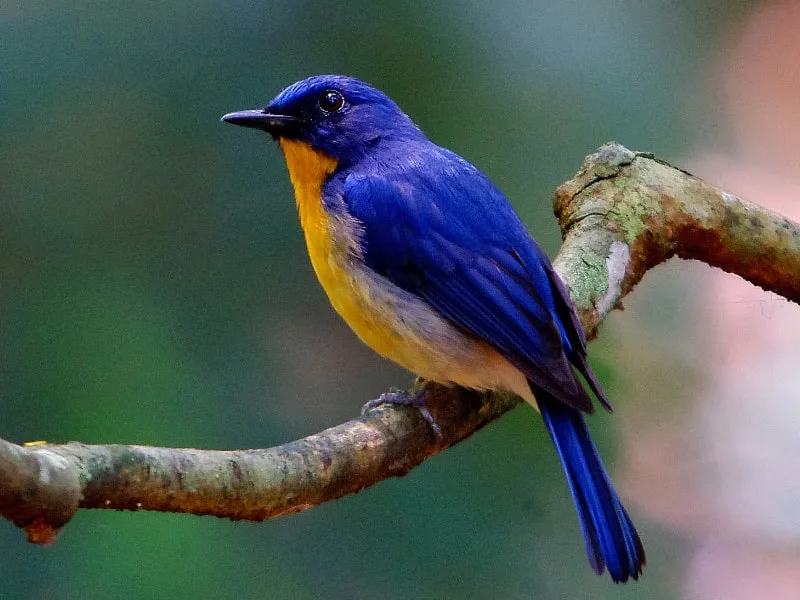
Tickell’s blue flycatcher is a small insectivorous songbird, measuring about 14 cm (5.5 in) in length. The adult male is strikingly colored, with vivid blue on the head, back, wings, and tail. The throat and chest are a rich orange, which fades gradually into a pale whitish belly. Females are less brightly colored, with bluish-gray upperparts and duller orange below. Its call is a sharp “tchik” note, while the song is a varied, musical series of whistled and scratchy notes, often delivered from a shaded perch.
Listen to the Tickell’s blue flycatcher call and song:
This species is found in lowland and foothill forests, scrub, and secondary growth throughout much of India, Sri Lanka, and parts of Southeast Asia, including Myanmar and Thailand. It adapts well to wooded parks and large gardens, where it can often be seen foraging near the ground or sallying out after flying insects. Tickell’s blue flycatcher is typically solitary or seen in pairs, especially during the breeding season. It nests in cavities, tree holes, or crevices in walls and is often more easily heard than seen.
Hill blue flycatcher (Cyornis whitei)
- How it looks: Small flycatcher with deep blue upperparts, orange throat and chest, and whitish belly.
- Where found: Submontane and montane forests from the Himalayan foothills through Southeast Asia; 400-2,000 m elevation, sometimes lower in winter.
- Conservation status: Least Concern; widespread but may be undergoing a slow population decline.

The hill blue flycatcher is a small forest flycatcher, about 15 cm (5.9 in) in length. Adult males are deep blue above, with a bright orange throat and chest that fade into a pale whitish belly. The species is very similar in appearance to Tickell’s blue flycatcher but tends to be slightly darker and may show a more extensive orange wash. Females are paler, with grayish-blue upperparts and buff-tinged underparts. Its vocalizations include a sharp “tchik” call and a rich, melodious warble that can be heard from dense cover during the breeding season.
Listen to the hill blue flycatcher call and song:
This species occurs widely across the Indomalayan region, from northeastern India, southern China, and northern Myanmar south through mainland Southeast Asia, including Thailand, Laos, Cambodia, Vietnam, and Peninsular Malaysia. It typically inhabits submontane and montane broadleaf forests at elevations between 400 and 2,000 m, occasionally higher. In some parts of its range, especially further west, individuals may descend to lowland forests during the non-breeding season. Although the population is suspected to be in slow decline due to habitat degradation, the species remains common in suitable habitats and is currently not considered at risk.
Indochinese blue flycatcher (Cyornis sumatrensis)
- How it looks: Small flycatcher with bright blue upperparts, orange throat and chest, and pale belly.
- Where found: Forests and wooded habitats across mainland Southeast Asia and parts of Sumatra.
- Conservation status: Least Concern; widespread, with a possibly decreasing but unquantified population.

The Indochinese blue flycatcher is a small forest songbird, about 15 cm (5.9 cm) in length. Adult males are brightly colored, with vivid blue plumage covering the head, back, wings, and tail. The throat and chest are orange, contrasting with a pale whitish belly. This species closely resembles other Cyornis flycatchers and can be difficult to distinguish in the field without close views. Females are duller overall, with grayish or brownish upperparts and a fainter orange wash on the chest. Its vocalizations include a sharp “tik” call and a variable, melodic song typically given from shaded perches.
Listen to the Indochinese blue flycatcher song:
This species inhabits lowland and hill forests throughout mainland Southeast Asia, including Thailand, Laos, Cambodia, Vietnam, and parts of Peninsular Malaysia, as well as Sumatra. It prefers humid forest understorey, forest edges, and secondary growth, where it feeds mainly on insects captured in short sallies or gleaned from foliage. Although forest loss may be affecting parts of its range, the species remains broadly distributed and relatively adaptable.
Javan blue flycatcher (Cyornis banyumas)
- How it looks: Small flycatcher with deep blue upperparts, orange throat and chest, and pale belly.
- Where found: Forests of Java, Indonesia, including ravines and bamboo thickets up to 1,300 m elevation.
- Conservation status: Critically Endangered; wild population rapidly declining due to trapping for the songbird trade.

The Javan blue flycatcher is a small forest bird, around 15 cm (5.9 in) in length, with deep blue plumage on the head, back, wings, and tail. The throat and chest are a warm orange that fades into a pale whitish belly. Females are duller, with brownish upperparts and a faint orange wash below. Its vocalizations include high-pitched whistles and short trills, which have made it a popular target in the Indonesian songbird trade.
This species is endemic to the island of Java, Indonesia, where it inhabits primary and secondary broadleaf forests, particularly along ravines and in bamboo thickets, up to elevations of 1,300 m. Formerly widespread and common, the species has undergone a dramatic decline over the past two decades due to intense trapping pressure. Today, it is believed to survive in only a few localities, all of which remain vulnerable to targeted trapping. The wild population is estimated at fewer than 1,000 individuals (possibly much lower) while tens of thousands are held in captivity. With an estimated decline of over 80% in the past 10 years and persistent demand from the bird trade, the species faces a serious risk of extinction in the near future.
Large blue flycatcher (Cyornis magnirostris)
- How it looks: Medium-sized flycatcher with deep blue upperparts, orange throat and chest, and pale belly.
- Where found: Breeds in montane forests of the eastern Himalayas; winters in lowland and hill forests of the Thai-Malay Peninsula.
- Conservation status: Near Threatened; suspected to be declining due to forest loss in non-breeding areas.
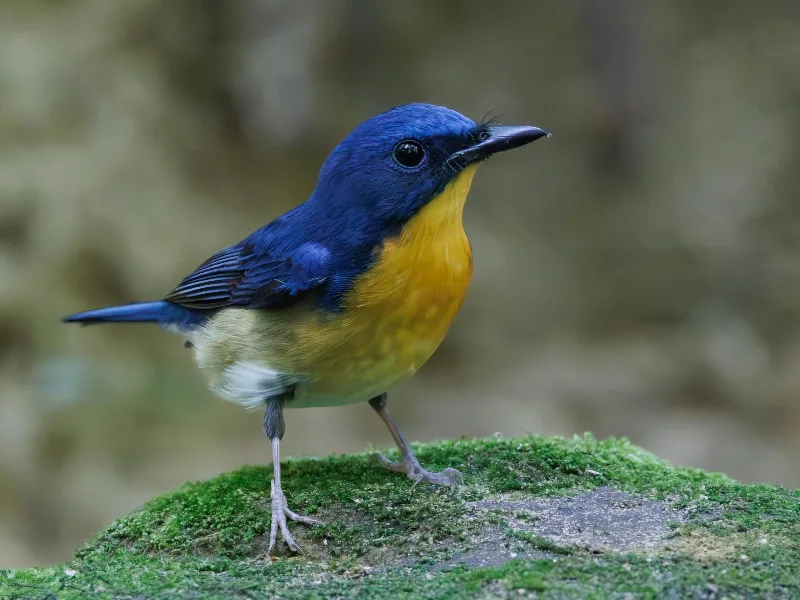
The large blue flycatcher is a medium-sized flycatcher, approximately 15 cm (5.9 in) in length. Adult males are rich cobalt blue above, with an orange throat and chest and a pale whitish belly. The bill is proportionally large and heavy for a flycatcher. Females are duller, with gray-brown upperparts and a faint orange wash below. Its vocalizations include a sharp, metallic “tink” and a soft, whistling song, usually delivered from cover in the forest midstorey.
Listen to the large blue flycatcher call and song:
This species breeds in subtropical montane forests of the eastern Himalayas, including Nepal, Bhutan, northeast India, and northern Myanmar. It winters in lowland and hill forests of the Thai-Malay Peninsula, especially in Thailand and Tenasserim. While not considered rare, the species is suspected to be undergoing a moderate decline due to habitat degradation in its wintering range. Continued forest loss in lowland Southeast Asia, particularly from logging and land conversion, is thought to be the main driver of this decline. Its inconspicuous habits and past confusion with similar species have made monitoring difficult.
Blue-throated blue flycatcher (Cyornis rubeculoides)
- How it looks: Small flycatcher with rich blue upperparts, bright blue throat, orange chest, and pale belly.
- Where found: Dense forests of the Indian Subcontinent and parts of Southeast Asia, including the Himalayas, Western Ghats, and Tenasserim Hills.
- Conservation status: Least Concern; widespread and stable across a broad range.

The blue-throated blue flycatcher is a small forest flycatcher, around 15 cm (5.9 in) in length. Adult males have deep blue upperparts and a bright blue throat, which clearly distinguishes them from similar species such as Tickell’s blue flycatcher. The chest is orange, fading into a pale whitish belly. Females are considerably duller, with brownish upperparts and a faint orange wash below. The species is often heard before it is seen, with a rich, whistling song and a sharp “chik” call given from shaded forest perches.
Listen to the blue-throated blue flycatcher call:
This species inhabits dense forests and thickly vegetated areas across much of the Indian Subcontinent and adjacent regions. It breeds in the Himalayan foothills and moist forests of northeast India, and is found in the Western Ghats and lowland forests of central and eastern India during the non-breeding season. Its range extends eastward into Bangladesh, northern Myanmar, and the Tenasserim Hills. Compared to other Cyornis flycatchers, it favors denser habitats with thick cover. Although habitat loss affects parts of its range, the species remains widespread and is currently assessed as Least Concern.
Chinese blue flycatcher (Cyornis glaucicomans)
- How it looks: Small flycatcher with rich blue upperparts, orange throat and chest, and pale belly.
- Where found: Broadleaf forests and wooded habitats in southern China and the Malay Peninsula, mostly below 1,200 m.
- Conservation status: Least Concern; population appears stable across a broad range.

The Chinese blue flycatcher is a small forest bird, around 15 cm (5.9 in) in length, with deep blue plumage on the head, back, and wings. The throat and chest are orange, blending into a pale belly. Males show a vivid contrast between the blue upperparts and the warmer underparts. Females are duller, with brownish tones above and a faint orange wash below. Its vocalizations include a sharp “tick” call and a rich, melodic song composed of variable whistles, typically heard from the lower canopy or forest understorey.
Listen to the Chinese blue flycatcher call:
This species occurs in the lowland and hill forests of southern China and the Malay Peninsula, generally below 1,200 m elevation. It favors dense, humid broadleaf woodland and secondary growth, often remaining within the shaded understorey while foraging. The species has a relatively large range and remains locally common in suitable habitat. Despite habitat pressures in parts of its range, the population is currently considered stable, and no significant decline has been detected. As a result, it is assessed as Least Concern.
Sunda blue flycatcher (Cyornis caerulatus)
- How it looks: Small flycatcher with deep blue upperparts, orange throat and chest, and pale belly.
- Where found: Lowland primary forests of Sumatra, Borneo (including Sabah, Sarawak, and Brunei).
- Conservation status: Vulnerable; affected by forest loss and possibly trade-related declines.

The Sunda blue flycatcher is a small, forest-dwelling bird, around 14 cm (5.5 in) in length. Adult males have glossy blue plumage on the head, back, and wings, with a rich orange throat and chest, and a pale whitish belly. Females are duller, with brownish upperparts and a light orange wash limited to the throat and upper chest. Its vocalizations are thin and high-pitched, with a brief whistling song and sharp contact calls, typically heard from the mid-storey of undisturbed forest.
Listen to the Sunda blue flycatcher song:
This species is patchily distributed across the Sunda region, including Sumatra, Kalimantan, Sabah, Sarawak, and Brunei. It inhabits lowland primary forests, usually below 500 m elevation, where it forages in the mid-levels of the forest interior or at the edges of clearings. Unlike some related species, it is rarely found in riverine habitats. Although never considered common, its apparent rarity and localized distribution suggest a steep population decline, likely driven by extensive deforestation and degradation of lowland rainforest across its range. In addition, the popularity of Cyornis flycatchers in the cagebird trade may be contributing to unquantified but significant pressure.
Mangrove blue flycatcher (Cyornis rufigastra)
- How it looks: Small flycatcher with rich blue upperparts, orange throat and chest, and whitish belly.
- Where found: Subtropical and tropical mangrove forests across Southeast Asia, including coastal areas of the Philippines, Thailand, Malaysia, and Indonesia.
- Conservation status: Least Concern; widespread but may be slowly declining due to habitat loss.

The mangrove blue flycatcher is a small coastal flycatcher, around 15 cm (5.9 in) in length. Adult males are brightly colored, with deep blue plumage on the head, back, and wings, and a strong orange wash across the throat and chest, blending into a pale belly. Some subspecies may show variation in the extent and shade of orange. Females are duller, with brownish or bluish-gray upperparts and less intense coloration below. The species has a pleasant, whistling song and a sharp “chit” or “tick” call, often heard from shaded lower branches near water.
Listen to the mangrove blue flycatcher song:
This species is native to coastal regions of Southeast and South Asia, including Brunei, Indonesia, Malaysia, the Philippines, Thailand, Singapore, and Sri Lanka. It is strongly associated with mangrove forests, although it may also use adjacent wooded areas and riverine edges. The mangrove blue flycatcher typically forages low in the vegetation, sallying out to catch insects. Although it remains widespread across its range, habitat degradation and the clearing of mangrove forest in many areas are likely contributing to a slow population decline.
Palawan blue flycatcher (Cyornis lemprieri)
- How it looks: Medium-sized flycatcher with dark blue upperparts, orange throat and chest, and pale belly.
- Where found: Endemic to Palawan and nearby islands in the western Philippines; found in lowland and submontane forests.
- Conservation status: Near Threatened; population declining due to forest loss, though some tolerance to habitat disturbance is noted.

The Palawan blue flycatcher is a medium-sized forest flycatcher, approximately 16 cm (6.3 in) in length. Adult males have dark blue plumage on the head, back, and tail, with an orange throat and chest and a contrasting pale belly. The overall coloration is deep and saturated, especially in shaded forest light. Females are duller, with brownish upperparts and orange chest. The species produces a series of short, whistled notes and a sharp, dry “chik” call, typically delivered from low understorey perches.
Listen to the Palawan blue flycatcher song:
This species is endemic to Palawan and adjacent islands including Balabac, Culion, and Calauit in the western Philippines. It inhabits lowland and submontane dry forest and second growth up to about 1,000 m elevation, where it forages actively in the lower and mid-storey. Though it prefers undisturbed forest, recent surveys have documented its presence in both early and mature secondary growth, and even in wooded agricultural areas, albeit in lower densities. The population is thought to be declining moderately due to ongoing lowland forest clearance and habitat degradation, particularly outside protected areas.
Sulawesi blue flycatcher (Cyornis omissus)
- How it looks: Small flycatcher with deep blue upperparts, orange throat and chest, and pale belly.
- Where found: Endemic to Sulawesi, Indonesia; inhabits lowland and montane forests.
- Conservation status: Least Concern; population may be declining slowly but remains widespread across the island.

The Sulawesi blue flycatcher is a small forest bird, around 15 cm (5.9 in) in length. Adult males show deep blue upperparts, an orange throat and chest, and a whitish belly. The blue can appear especially vivid in good light. Females are paler, with grayish or brownish-blue upperparts and a weaker orange wash below. The species is vocally active during the breeding season, producing short, melodic whistles and a dry contact call from shaded perches in the forest understorey.
Listen to the Sulawesi blue flycatcher call:
Endemic to Sulawesi and surrounding smaller islands in Indonesia, this species inhabits subtropical and tropical moist forests from the lowlands to montane zones. It can be found in both primary and secondary growth, typically between lower elevations and mid-montane levels. Though its population trend is suspected to be slowly decreasing, mainly due to habitat disturbance and forest degradation, it remains relatively widespread and locally common in suitable areas.
Malaysian blue flycatcher (Cyornis turcosus)
- How it looks: Small flycatcher with vivid blue upperparts, orange throat and chest, and whitish belly.
- Where found: Riparian forests of the Sundaic lowlands, including Peninsular Malaysia, Sumatra, Borneo, and Brunei; mostly below 500 m.
- Conservation status: Near Threatened; declining due to widespread loss of lowland riverine forest.

The Malaysian blue flycatcher is a small, streamside specialist, measuring about 14 cm (5.5 in) in length. Males are brightly colored, with cobalt-blue upperparts and a rich orange throat and chest that blend into a pale belly. Slightly paler females have grayish-blue upperparts, an orange chest, and a whitish throat, while the male’s throat is blue. Its song is a series of soft, whistled phrases, and the call is a sharp, dry “tchik,” typically heard near shaded streambanks.
Listen to the Malaysian blue flycatcher call:
This species is endemic to the Sundaic lowlands of Southeast Asia, where it is found in Peninsular Thailand, Peninsular Malaysia, Sumatra, Borneo (including Sabah, Sarawak, and Kalimantan), and Brunei. It is a specialist of lowland riparian and streamside forests, often in primary or mature secondary growth. On the Malay Peninsula, it is largely restricted to forest below 200 m, while in Borneo it can occur up to at least 500 m, and occasionally higher. Although still relatively widespread, the Malaysian blue flycatcher is in decline due to the extensive clearing and degradation of lowland forests throughout its range, especially near watercourses.
Dayak blue flycatcher (Cyornis montanus)
- How it looks: Small flycatcher with dark blue upperparts, orange throat and chest, and pale belly.
- Where found: Endemic to submontane forests of Borneo between 400-1,400 m elevation.
- Conservation status: Least Concern; population may be slowly declining, but remains widespread in upland forest zones.

The Dayak blue flycatcher is a small understorey bird of submontane forest, about 15 cm (5.9 in) in length. Adult males have dark blue upperparts and face, with an orange throat and chest that transitions into a pale belly. The blue is rich and saturated, especially on the wings and crown. Females are brownish overall, with a faint orange on the chest and paler underparts. Its vocalizations include soft, whistled notes and a sharp “tchik” or “tsit” call, delivered from low shaded perches.
This species is endemic to the highland regions of Borneo, where it occurs in Malaysian Borneo (Sabah and Sarawak), Brunei, and Kalimantan, Indonesia. It inhabits submontane broadleaf forests between 400 and 1,400 m, preferring dense undergrowth and the shaded lower storey. Though generally inconspicuous, it is present in suitable habitats across its known range. The population may be declining slowly due to forest disturbance, but no rapid or large-scale decline has been detected.
Bornean blue flycatcher (Cyornis superbus)
- How it looks: Small flycatcher with dark blue upperparts, vivid orange chest, and pale belly.
- Where found: Endemic to montane forests on the island of Borneo, including Brunei, Indonesia, and Malaysia.
- Conservation status: Least Concern; population trend uncertain but not declining rapidly.

The Bornean blue flycatcher is a small flycatcher of upland forest, about 15 cm (5.9 in) in length. Adult males have dark blue upperparts, including the crown, mantle, wings, and tail, with almost blackish-blue cheeks and facial area around the eyes. The throat and chest are bright orange, contrasting with a pale belly. Females are brownish overall with a paler orange to yellowish chest and lighter underparts. The species’ vocalizations include soft whistles and high, thin calls, often given from low, shaded perches in the understorey.
Listen to the Bornean blue flycatcher call:
This species is endemic to Borneo, found in Brunei, Malaysian Borneo (Sabah and Sarawak), and Kalimantan, Indonesia. It inhabits moist montane forests, typically above 1,000 m, where it forages in the understorey and lower midstorey, sometimes near forest trails or gaps. Though little is known about detailed population dynamics, it is considered locally uncommon but stable in suitable habitat. With no evidence of a rapid decline and a fairly wide distribution in upland areas, it is currently assessed as Least Concern.
Meratus blue flycatcher (Cyornis kadayangensis)
- How it looks: Medium-sized flycatcher with dark blue upperparts, orange throat and chest, and pale belly.
- Where found: Endemic to the Meratus Mountains of southeastern Borneo (Kalimantan, Indonesia); found in hill forests from 500-1,300 m.
- Conservation status: Near Threatened; locally common, but threatened by habitat loss and potential trapping.

The Meratus blue flycatcher is a medium-sized forest flycatcher, about 16 cm in length, recently described in 2022. Adult males have dark blue plumage across the head, back, and wings, with a warm orange throat and chest fading into a pale belly. The face and lores are also dark blue, giving a masked appearance. Females are brownish overall, lacking any blue, with a pale underside and faint orange wash on the chest. The species produces soft, whistled notes and a short, dry “tik” call, often heard from lower forest strata.
Endemic to the Meratus Mountains of southeastern Kalimantan, Indonesia, this species inhabits hill forests between 900 and 1,300 m, with at least one confirmed record from as low as 500 m. It is found in primary and mature secondary forest, as well as overgrown rubber plantations within forested landscapes. Although the species has a very limited range, it is currently considered locally common within suitable habitat. Forest loss and potential trapping for the cagebird trade may pose growing threats, but declines are believed to be slow.
Timor blue flycatcher (Eumyias hyacinthinus)
- How it looks: Medium-sized flycatcher with deep blue upperparts, orange throat and chest, and whitish belly.
- Where found: Forests and wooded areas on Timor and surrounding islands in the Lesser Sundas.
- Conservation status: Least Concern; population may be slowly declining but remains widespread.

The Timor blue flycatcher is a medium-sized flycatcher, about 16 cm (6.3 in) in length. Adult males have rich blue plumage on the head, throat, back, and wings, with an orange chest and belly. The blue tones may appear more violet or indigo in certain light. Females are noticeably duller, with brownish upperparts and a faint orange wash on the throat and upper chest. Its vocalizations include a short, whistled song and a dry, high-pitched “tzeep” call given from shaded perches.
Listen to the Timor blue flycatcher song:
This species is native to Timor and nearby islands in the Lesser Sunda chain, where it inhabits primary and secondary forests, forest edges, and dense woodland. It is often found from low elevations into the foothills, though elevation limits are not well documented. The Timor blue flycatcher is generally considered uncommon to locally common, depending on habitat condition.
Pygmy flycatcher (Ficedula hodgsoni)
- How it looks: Tiny flycatcher with deep blue upperparts, bright orange throat and chest, and whitish belly.
- Where found: Montane forests across the eastern Himalayas, Indochina, the Malay Peninsula, Sumatra, and Borneo.
- Conservation status: Least Concern; widely distributed with a stable population trend.

The pygmy flycatcher is one of Asia’s smallest passerines, measuring just about 10 cm (3.9 in) in length. Adult males are striking despite their size, with deep blue upperparts, a vivid orange throat and chest, and a clean whitish belly. The compact body and relatively large head give it a distinctive silhouette. Females are much duller, with olive-brown upperparts and a faint orange wash on the chest. Its vocalizations are high-pitched and thin, often consisting of soft whistles and short notes delivered from cover.
Listen to the pygmy flycatcher call:
This species inhabits subtropical and tropical moist montane forests throughout a broad elevational range. It is found from the eastern Himalayas through Indochina, down the Malay Peninsula, and across to Sumatra and Borneo. Typically favoring the forest understorey and lower midstorey, it forages quietly among mossy branches and dense foliage. Though often inconspicuous, it remains locally common in suitable highland forest and shows no signs of significant population decline.
Closing notes
Birds with blue and orange plumage can be found in a surprising range of habitats, from North American meadows and Asian forests to African savannas and tropical riversides. While many species share similar colors, close attention to details like size, call, range, and habitat can help narrow down the possibilities. We’ve put together an extensive list, but there are certainly other birds out there that fit this color pattern. If you’ve seen a species that matches but isn’t included here, we encourage you to share it, especially if it’s local, migratory, or easily overlooked.
